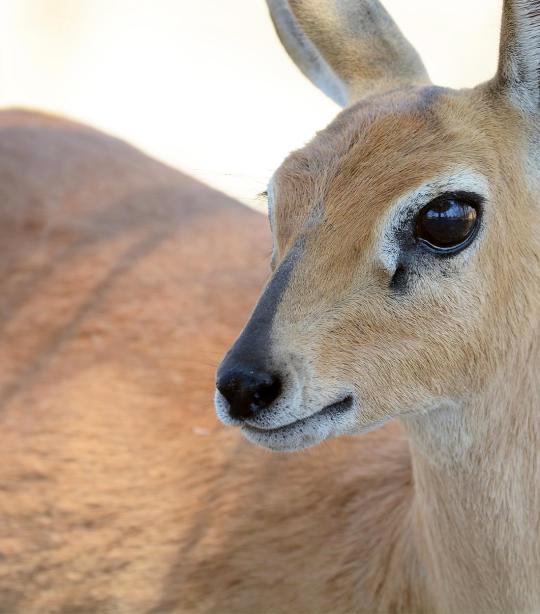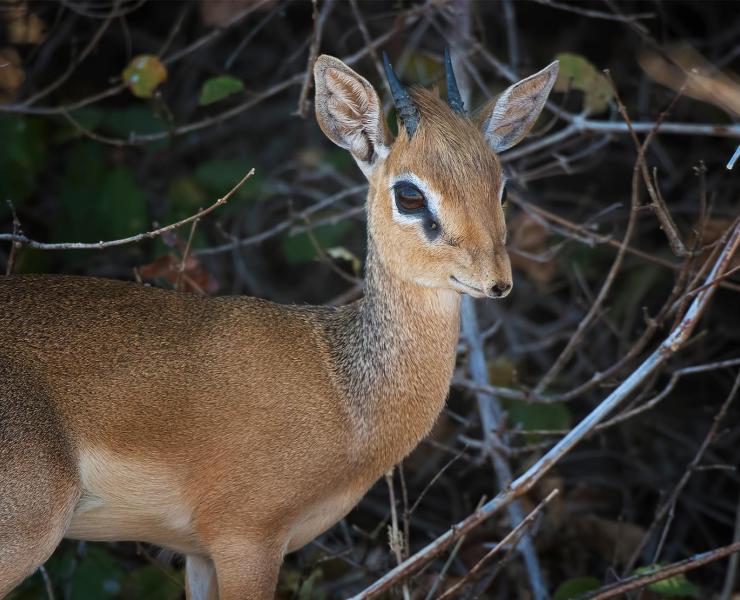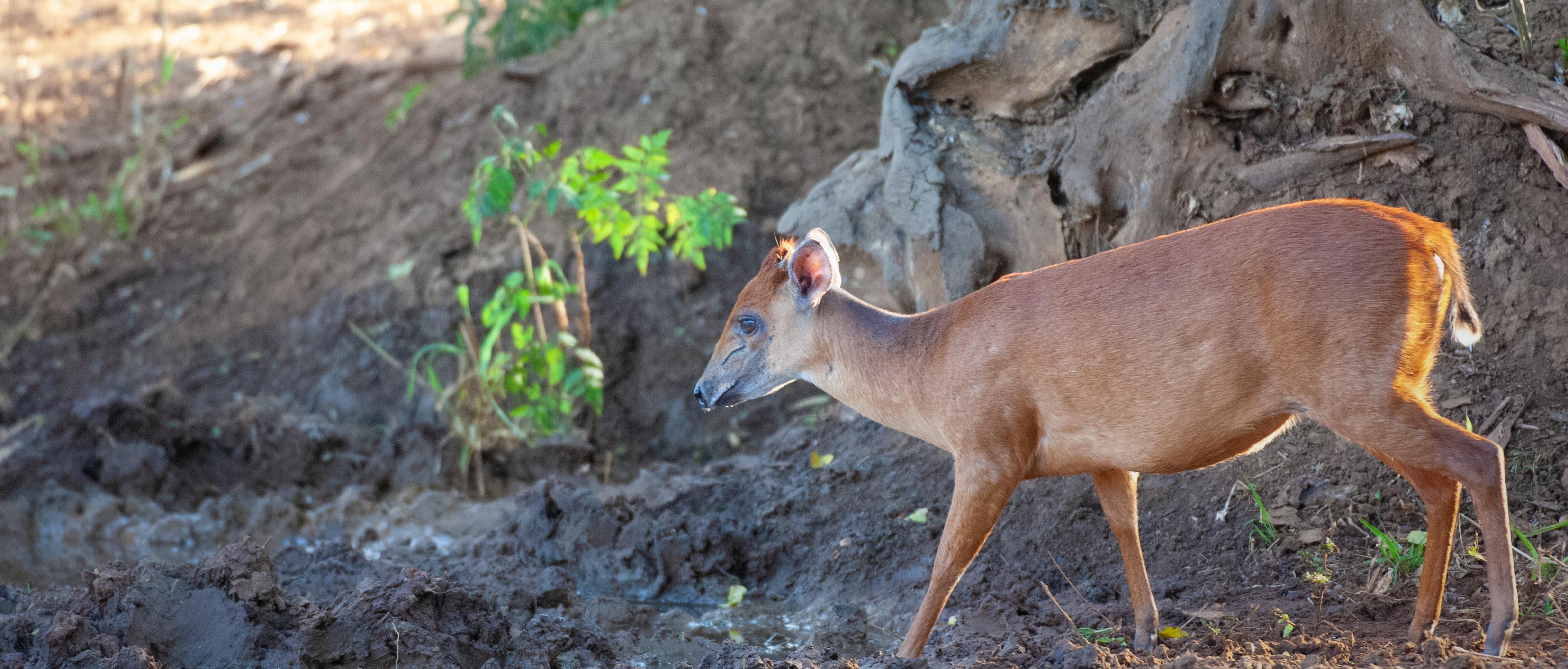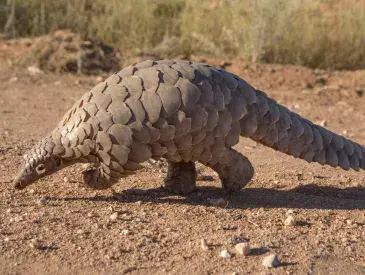What is a duiker?
A striking peculiarity of the duikers in the genus Cephalophus is that they all have the same distinctive body type, although the different species vary in size. They have low-slung bodies on slender legs, wedge-shaped heads topped by a crest of long hair, and relatively large eyes. With their heads held close to the ground, these small antelopes can move easily through the dense vegetation of forests and bushlands. They regularly run through these areas and when disturbed, plunge into thick cover to hide. This trait is the source of the name “duiker,” which in Dutch means “diver.”
Environment and habitat can influence the overall body shape and coloration of animals. Thus, the duiker living in open habitat is longer-legged, less hunchbacked, and lighter in color (tawny or gray) than the species that inhabit the dense, dark forests.
The bush duiker is represented by only one species known as the common or Grimm’s duiker. This is the most widely distributed of the species in East Africa and is found in a large range of habitats at different elevations, but never in the deep forest. Unlike the forest species, the bush duiker has longer legs and can run fast for long distances. All duikers freeze and crouch to escape detection. They have dark, glossy coats and tails that have white hair that contrasts with the dark body. The tail is constantly in motion with each movement looking like a tiny torch being switched on and off in the forest gloom.
Male and female forest duikers are about the same size, and both have horns. Their horns are small and spike-like, lying so flat against the head that they are not too useful in fighting. Bush duiker females are larger than males, but they usually do not have horns.
The smallest of the species is the blue duiker, which in East Africa is found in Uganda, western Kenya, and parts of Tanzania. The largest is the yellow-backed duiker, which ranges across the whole of the African tropical forest block. Populations of the yellow-backed duiker are also found on Mt. Elgon and the Mau in Kenya. This duiker reaches up to 88 centimeters (35 inches) in height and 80 kilograms (175 pounds) in weight. It has distinctive, long whitish-yellow to orange hair that stands erect on the back.
Blue duiker (Cephalophus monticla); Yellow-backed duiker (Cephalophus silvicultor); Bush duiker (Sylvicapra grimmia)
Dependent on subspecies
Dependent on subspecies
Up to 12 years in captivity
Forests, coastal scrublands, farmland, and bush
Omnivorous
5 to 7 months
Humans, eagles, lions, and leopards

Challenges
Humans are encroaching on their habitats.
Duikers are losing their habitats to the expansion of roads, settlements, and agriculture as a result of human population growth and are being pushed into close quarters with humans.
Duikers are hunted by humans.
The animals are hunted for their meat, skins, and horns, which are popular in some areas as charms against evil spirits. Bush duikers may be hunted in reprisal for raiding crops.
Solutions
Our solutions to protecting the duiker:
African Wildlife Foundation brings together communities and private investors to construct conservation tourism lodges, like Koija Starbeds Lodge, in Kenya. The lodge provides sustainable income for the community and the 500-acre conservancy is a safe home to a variety of wildlife.
AWF works with governments and villages to designate wildlife corridors — large swaths of land that duikers, and other wildlife, use to roam freely and safely from one park, or country, to another. Corridors link protected areas and allow this species to follow rains or travel to their calving grounds.


Behaviors
Duikers are extremely well-groomed.
The pairs devote a great deal of time to grooming one another’s heads, which aids in bonding pairs; it may also help individuals recognize their species and discourage interbreeding with others.
Males fight for their property rights.
Males fight, especially when their territory is invaded. They inhabit fairly small territories marked with the secretions from the preorbital gland below each eye. Even though a pair will live together in the territory, they will spend most of the time apart.
They play hard to get.
This species’ courtship involves prolonged and noisy chases about the territory before mating, after which a single calf is born. A calf can run within hours of birth but usually lies hidden for long periods of time between suckling. It grows rapidly and is adult-sized at six to seven months. The young utter a loud bleat when in danger, quickly signaling adults in the area.
Diet
Duikers enjoy a varied diet.
Their large mouth permits them to feed on sizable fruits, mushrooms, and other bulky items. They also eat berries and fruits that have fallen naturally, as well as those dropped by monkeys, but most of their diet consists of foliage from bushes and trees. On occasion, they may eat insects, lizards, birds, and rodents.
Habitats
Where do duikers live?
The little blue duiker and yellow-backed duiker species live in montane, riverine, and rain forests. The bush duiker lives mostly in moist savannas and avoids rain forests.



